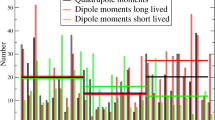Abstract
Nuclear magnetic resonance spectrometers presently available are unable to recognize the two mirror-image forms of a chiral molecule, because in the absence of a chiral solvent, the NMR spectral parameters (chemical shifts and spin–spin coupling constants) are identical for the two enantiomers. This paper discusses how chirality may nevertheless, at least in theory, be recognized in liquid-state NMR spectroscopy by applying strong d.c. electric fields and measuring a pseudoscalar contribution to nuclear spin–spin coupling polarizability. Calculations are reported for medium-size chiral molecules, (2R)-N-methyloxaziridine, (R a )-1,3-dimethylallene, and (2R)-2-methyloxirane. The very small contributions provided by the pseudoscalar of nuclear spin–spin coupling polarizability seem rather difficult to detect via NMR experiments in disordered phase.

Similar content being viewed by others
References
Barra AL, Robert JB (1996) Mol Phys 88:875–886
Laubender G, Berger R (2003) Chem Phys Chem 4:395–399
Soncini A, Faglioni F, Lazzeretti P (2003) Phys Rev A 68:0334021–4
Buckingham AD (2004) Chem Phys Lett 398:1–5
Buckingham AD, Fischer P (2006) Chem Phys 324:111–116
Zanasi R, Pelloni S, Lazzeretti P (2007) J Comput Chem 28:2159–2163
Pelloni S, Lazzeretti P, Zanasi R (2007) J Chem Theor Comput 3:1691–1698
Lazzeretti P, Soncini A, Zanasi R (2008) Theor Chem Acc 119:99–106
Grayson M (2003) Int J Mol Sci 4:218–230
Buckingham AD, Pople JA (1955) Proc Phys Soc A 68:905–909
Barron LD (1982) Molecular light scattering and optical activity. Cambridge University Press, Cambridge
Buckingham AD (1967) Adv Chem Phys 12:107–142
Ramsey NF (1953) Phys Rev 91:303–307
Pyykkö P (2000) Theor Chem Acc 103:214–216
Lazzeretti P (1989) Chem Phys 134:269–278
Lazzeretti P (1987) Adv Chem Phys 75:507–549
Lazzeretti P (2003) Electric and magnetic properties of molecules. In: Handbook of molecular physics and quantum chemistry, vol 3, Part 1, Chapter 3, Wiley, Chichester
Mohr PJ, Taylor BN (2005) Rev Mod Phys 77:1–107
Linderberg J, Öhrn Y (1973) Propagators in quantum chemistry. Academic Press, London
Oddershede J, Jørgensen P, Yaeger DL (1984) Computer Phys Rep 2:33–92
Olsen J, Jorgensen P (1985) J Chem Phys 82:3235–3264
Becke AD (1993) J Chem Phys 98:5648–5652
Lee C, Yang W, Parr RG (1988) Phys Rev B 37:785–789
Vosko SH, Wilk L, Nusair M (1980) Can J Phys 58:1200–1211
Stephens PJ, Devlin FJ, Chabalowski CF, Frisch MJ (1994) J Phys Chem 98:11623–11627
Keal W, Tozer DJ (2003) J Chem Phys 119:3015–3024
Keal W, Tozer DJ (2004) J Chem Phys 121:5654–5660
Perdew JP, Burke K, Ernzerhof M (1996) Phys Rev Lett 77:3865–3868
DALTON, An electronic structure program, Release 2.0; 2005. http://www.kjemi.uio.no/software/dalton/
Frisch MJ, Trucks GW, Schlegel HB, Scuseria GE, Robb MA, Cheeseman JR, Montgomery JA Jr, Vreven T, Kudin KN, Burant JC, Millam JM, Iyengar SS, Tomasi J, Barone V, Mennucci B, Cossi M, Scalmani G, Rega N, Petersson GA, Nakatsuji H, Hada M, Ehara M, Toyota K, Fukuda R, Hasegawa J, Ishida M, Nakajima T, Honda Y, Kitao O, Nakai H, Klene M, Li X, Knox JE, Hratchian HP, Cross JB, Bakken V, Adamo C, Jaramillo J, Gomperts R, Stratmann RE, Yazyev O, Austin AJ, Cammi R, Pomelli C, Ochterski JW, Ayala PY, Morokuma K, Voth GA, Salvador P, Dannenberg JJ, Zakrzewski VG, Dapprich S, Daniels AD, Strain MC, Farkas O, Malick DK, Rabuck AD, Raghavachari K, Foresman JB, Ortiz JV, Cui Q, Baboul AG, Clifford S, Cioslowski J, Stefanov BB, Liu G, Liashenko A, Piskorz P, Komaromi I, Martin RL, Fox DJ, Keith T, Al-Laham MA, Peng CY, Nanayakkara A, Challacombe M, Gill PMW, Johnson B, Chen W, Wong MW, Gonzalez C, Pople JA (2004) Gaussian 2003, Revision C.02. Gaussian, Inc., Wallingford, CT
Sadlej AJ (1988) Collect Czech Chem Commun 53:1995–2016
Dunning TH Jr (1989) J Chem Phys 90:1007–1023
Woon DE, Dunning TH Jr (1995) J Chem Phys 103:4572–4585
van Duijneveldt FB (1971) Gaussian basis sets for the atoms H-Ne for use in molecular calculations. Res Report RJ 945, IBM
Enevoldsen T, Oddershede J, Sauer SPA (1998) Theor Chem Acc 100:275–284
Provasi PF, Aucar GA, Sauer SPA (2001) J Chem Phys 115:1324–1334
Barone V, Provasi PF, Peralta JE, Snyder JP, Sauer SPA, Contreras RH (2003) J Phys Chem A 107:4748–4754
Rusakov YY, Krivdin LB, Sauer SPA, Levanova EP, Levkovskaya GG (2010) Magn Res Chem 48:633–637
Provasi PF, Sauer SPA (2010) J Chem Phys 133:54308
Jensen F (2006) J Chem Theory Comput 2:1360–1369
Benedikt U, Auer AA, Jensen F (2008) J Chem Phys 129:64111
Giorgio E, Viglione RG, Zanasi R, Rosini C (2004) J Am Chem Soc 126:2968
Acknowledgments
Financial support (UBACYT X079 from the University of Buenos Aires and PIP0369 from CONICET) is gratefully acknowledged. SPAS acknowledges support from the Danish Center for Scientific Computing (DCSC) and the financial support from the Carlsberg Foundation and from the Danish Natural Science Research Council/The Danish Councils for Independent Research (grant number 272-08-0486).
Author information
Authors and Affiliations
Corresponding author
Additional information
Dedicated to Professor Pekka Pyykkö on the occasion of his 70th birthday and published as part of the Pyykkö Festschrift Issue.
Contribution to honor the scientific work and life of Prof. Pekka Pyykkö.
An erratum to this article can be found at http://dx.doi.org/10.1007/s00214-011-1017-6
Electronic supplementary material
Below is the link to the electronic supplementary material.
Rights and permissions
About this article
Cite this article
Pagola, G.I., Ferraro, M.B., Pelloni, S. et al. Electric field effects on nuclear spin–spin coupling tensors and chiral discrimination via NMR spectroscopy. Theor Chem Acc 129, 359–366 (2011). https://doi.org/10.1007/s00214-010-0851-2
Received:
Accepted:
Published:
Issue Date:
DOI: https://doi.org/10.1007/s00214-010-0851-2




